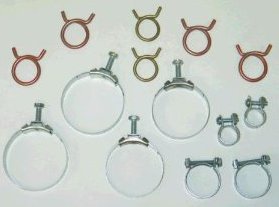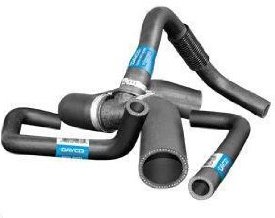Checking cooling hoses before a summer trip
Checking cooling hoses before a summer trip sounds like a boring topic to discuss. But if you think about how a blown hose could destroy a summer weekend, then it might just be worth a read. Of course the more mileage on the road trip vehicle the greater the likelihood that original equipment cooling system hoses could experience a problem.

There are three main things that should be inspected on all cooling system hoses on a regular basis. These would be (in no special order) leaking, chafing or rubbing and swelling. When it comes to checking for leaking hoses most often a problem that is developing will be visible at the hose clamp connection.
There are several different kinds of hose clamps and all of them are capable of having problems. The factory installed spring clamp can lose its spring force over time and develop small cooling leaks or seepage. A telltale sign of this common condition is a crusty or corroded looking area at the connection just in front of the clamp.
This is an invitation to solve the small car problem before it turns into a large one that requires a tow truck and a change of plans. Screw type hose clamps can also loosen up and have reduced clamping force. Back in my dealership days many services included tightening hose clamps during oil change services. You have to be gentle though because Screw clamps can also strip out and lose their ability to be tightened.
Checking cooling hoses video
A visual inspection of all coolant system hoses is a good idea before any road trip. I posted a video on my other website if you would like to take a look. It’s only three minutes and opens in a new window. It is provided by Haynes car care channel and talks about checking cooling hoses. One issue that is not covered real well in the video would be how you should check radiator hoses or rubbing or chafing.
On modern vehicles the engine compartment can be packed together with little room for mistakes or miss routing of coolant hoses. If a hose is out of position it can rub against a metal bracket or even a moving engine belt. This may not cause an instant problem but over time can wear away at the rubber outer wall and cause it to burst when it is under pressure.
Signs of coolant hose problems

Sometimes it can be hard to see that a hose is not in good condition because normally cooling system hoses begin to deteriorate from the inside. Any external bulging or cracking of these rubber parts is a definite sign of an imminent failure. You should change any hose that feels mushy or extremely brittle when squeezed firmly.
If a coolant system hose becomes soft it is a sign that it is deteriorating from the inside and it should be replaced before taking that long summer road trip. If the hose is hard or feels like it is crackling as it is squeezed this would be considered a brittle hose and this also should be replaced before hitting the road. Note that if you do not know what it supposed to feel like you can go into a parts store and squeeze a new one.
When it comes to cooling hoses that ruin a summer trip, the upper radiator hose is subject to the roughest service life of any of the rubber parts in the system. It must absorb more engine motion than any of the other hoses. It is exposed to the coolant at its hottest stage and is insulated by the hood which can cause even higher temperatures. This is why an upper radiator hose can be the first one to show signs of problems.
If you find an upper radiator hose that do need to be replaced consider replacing the other hoses and the engine thermostat for good measure. Especially if the vehicle has well over 100,000 miles and these parts are all original. In my opinion another hose that should be carefully inspected would be the bypass hose. This hose is usually small or short in overall length and on many models it is located between the water pump in the engine block.
This puts it in a position where it is also subject to a tremendous amount of heat with very little ventilation or a chance to dissipate the heat that is built up. Although chemical degradation of the rubber from engine coolant is the most common cause of a hose failure heat buildup is probably a close second when it comes to cooling system hoses that ruin a summer trip.
If you would like to see more articles and the most recent posts to this website this next link will take you back to the blog home page from this article about coolant hose problems. It may also be helpful to review the other articles in the auto repair information section before going on that summer road trip.

